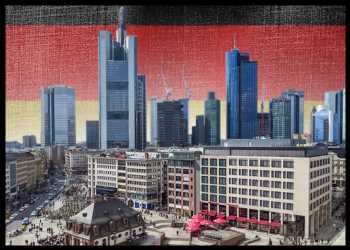The German economy entered a technical recession in the first quarter, in contrast to the initial estimate, as high inflation damped household consumption, official data revealed Thursday.
Gross domestic product declined a seasonally and calendar adjusted 0.3 percent from the fourth quarter of last year, when the economy shrank 0.5 percent, Destatis reported. The initial reading for the first quarter was nil growth.
“After growth entered negative territory at the end of 2022, the German economy has now recorded two consecutive negative quarters,” Destatis President Ruth Brand said.
Two consecutive quarters of output contraction is defined as a technical recession.
High inflation continued to be a burden on the biggest euro area economy and mainly hurt household spending, Destatis said.
However, a private survey released on Thursday said households were more positive about their income growth amid the hope of a rise in wages and salaries resulting in a less severe loss of purchasing power.
The GfK consumer confidence index advanced to -24.2 in June from a revised -25.8 in May. The sentiment is still below the level of Spring 2020 during the first corona breakdown.
Income expectations continued its recovering trend, while both the propensity to buy and economic expectations have suffered slight losses in May, the survey showed.
The expenditure-side breakdown of GDP showed that household consumption shrunk 1.2 percent sequentially as consumers spend less on food and beverages, clothing and footwear, and on furnishings. Consumption fell 1.7 percent in the fourth quarter.
Demand for new cars was also less due to the discontinuation of grants for plug-in hybrids and the reduction of grants for electric vehicles at the start of 2023.
State spending decreased 4.9 percent, reversing a 0.2 percent gain a quarter ago.
Investments grew in the first quarter led by a 3.9 percent gain in construction, thanks to the good weather. Gross fixed capital formation in machinery and equipment rose 3.2 percent.
Exports grew 0.4 percent underpinned by the robust increase in shipments of plastics and fabricated metal products. The increase reversed the 1.3 percent fall in the prior quarter.
However, imports decreased 0.9 percent, partly due to reduced imports of mineral fuels such as crude oil and mineral oil products, and chemicals and chemical products. Nonetheless, this was slower than the 2.4 percent fall seen a quarter ago.
On a year-on-year basis, GDP shrunk 0.2 percent, reversing a similar size growth from the previous three months. The rate was unchanged from the flash estimate published on April 28.
Capital Economics’ economist Franziska Palmas said the economy is likely to weaken further.
Higher interest rates will continue to drag consumption and investment and exports may also suffer amid economic weakness in other developed markets, the economist noted.
A drop in purchasing power coupled with thinned-out industrial order books, aggressive monetary policy tightening, and the expected slowdown of the US economy, all argue in favor of weak economic activity in Germany, ING economist Carsten Brzeski said.
Earlier this month, the European Commission projected Germany’s real GDP growth to slow sharply to 0.2 percent this year before improving to 1.4 percent in 2024 on the back of a recovery in consumption and investment.
The International Monetary Fund had provided a weaker outlook for the German economy. The lender forecast GDP to shrink 0.1 percent this year and to expand only 1.1 percent in 2024.
Source: Read Full Article
-
Compulsory super only really benefits one group of workers
-
China Service Sector Growth Strengthens On New Business
-
ZIM Integrated Shipping Q4 Results Down, But Top Estimates; Stock Up In Pre-market
-
Powell Says Fed 'Will Not Hesitate' To Resume Raising Interest Rates
-
Eurozone Record High Core Inflation Confirmed; Labor Costs Rise Faster

